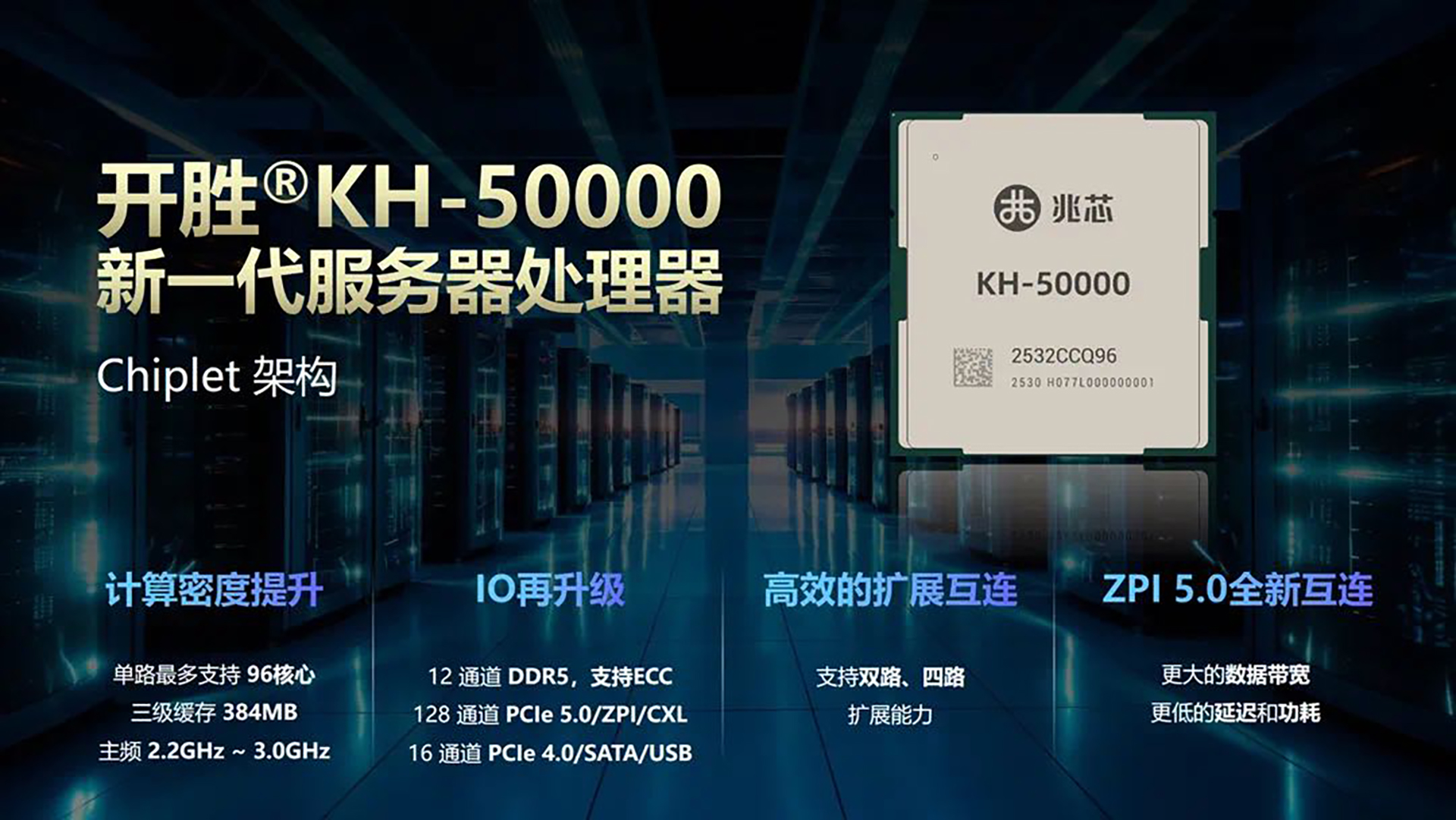Chinese CPUs are closing the gap on AMD — next-gen Zhaoxin chips feature 96 cores, 12-channel DDR5 memory, and 128 PCIe 5.0 Lanes

Zhaoxin, one of China's top fabless semiconductor companies, has announced the company's next-generation KaiXian KX-7000N and Kaisheng KH-50000 processors at the World Artificial Intelligence Conference (WAIC) 2025. The former is a new consumer chip for AI PCs, while the latter is a server chip with specifications that rival AMD's EPYC portfolio.
The Kaisheng KH-50000, the successor to the Kaisheng KH-40000, will feature up to 96 cores, aligning with AMD's EPYC 9004 (codenamed Genoa) series. The forthcoming server processors provide three times the number of cores compared to Zhaoxin's current models. Nevertheless, the company has not disclosed whether the Kaisheng KH-50000 will incorporate simultaneous multithreading (SMT) or continue to operate without SMT, as is the case with the Kaisheng KH-40000.
While the Kaisheng KH-40000 employs Zhaoxin's Yongfeng architecture, the company has not disclosed which architecture is utilized for the Kaisheng KH-50000. However, considering the significant upgrades in specifications and features, it is reasonable to assume that the Kaisheng KH-50000 adopts a new architecture. Zhaoxin just didn't want to reveal which one yet.
Zhaoxin Kaisheng KH-50000 Processor Specifications
Processor | Architecture | Cores / Threads | Base Clock (GHz) | L3 Cache (MB) | PCIe Lanes | Memory Support | ZPI Support |
|---|---|---|---|---|---|---|---|
Kaisheng KH-50000 | ? | 96 / ? | 2.2 - 3.0 | 384 | 128 PCIe 5.0 | 12-channel DDR5 | ZPI 5.0 |
Kaisheng KH-40000 | Yongfeng | 32 / 32 | 2.5 | 64 | 128 PCIe 3.0 | 8-channel DDR4 | ZPI 3.0 |
In terms of clock speed, Zhaoxin may achieve a range between 2.2 GHz and 3.0 GHz for the Kaisheng KH-50000. This may be higher or lower than the Kaisheng KH-40000, which operates at 2.5 GHz. The increase in core count is also associated with an expansion of the L3 cache. Zhaoxin has officially confirmed that the Kaisheng KH-50000 is equipped with 384MB of L3 cache, a capacity that is six times greater than that of the Kaisheng KH-40000.
You may be aware that AMD's Genoa processors include 384MB of L3 cache. Indeed, the Kaisheng KH-50000 could potentially be an identical counterpart to Genoa. Similar to Genoa, the Kaisheng KH-50000 provides 128 PCIe 5.0 lanes and support for 12-channel DDR5 ECC memory, in addition to embracing the Compute Express Link (CXL) interconnect.
The Kaisheng KH-50000 supports ZPI (Zhaoxin Processor Interconnect) 5.0, allowing partners to install two or four chips on one motherboard. This enables systems with up to 384 cores.
KaiXian KX-7000N
Zhaoxin is riding the AI PC trend. The company revealed the upcoming KaiXian KX-7000N processor at WAIC. This chip is likely based on the KaiXian KX-7000 but features an added NPU for AI tasks, which is probably what the "N" signifies in its name.
Get Tom's Hardware's best news and in-depth reviews, straight to your inbox.
The KaiXian KX-7000N marks a significant milestone for Zhaoxin, as it is the company's first chip to feature an NPU. Several AI PCs featuring the KaiXian KX-7000N were showcased at the WAIC 2025 event. However, Zhaoxin did not provide detailed specifications for the KX-7000N, only mentioning that it will have more cores and enhanced support for PCIe 5.0, unlike the current KaiXian KX-7000, which is limited to PCIe 4.0.
Companies such as Zhaoxin and Lisuan Technology are making significant advances in hardware. Although Chinese-made processors and graphics cards haven't yet challenged industry giants like Intel, AMD, or Nvidia, that remains a future objective. Currently, their focus is on creating reliable products that deliver a decent enough computing experience. Each progress, big or small, moves China closer to achieving technological independence from the West.
Follow Tom's Hardware on Google News to get our up-to-date news, analysis, and reviews in your feeds. Make sure to click the Follow button.

Zhiye Liu is a news editor, memory reviewer, and SSD tester at Tom’s Hardware. Although he loves everything that’s hardware, he has a soft spot for CPUs, GPUs, and RAM.
-
Joshua Thornton Even though it's all using stolen technology and IP, their progress is impressive.Reply -
bcountry71 It's one thing to start from scratch and build up the tech from nothing but communist china has pulled off the biggest tech theft in the history of mankind and it's mostly because of the western nations lust for short term profits from cheap labor but will now end up destroying the western companies because of it.Reply -
93QSD5 Replybcountry71 said:It's one thing to start from scratch and build up the tech from nothing but communist china has pulled off the biggest tech theft in the history of mankind and it's mostly because of the western nations lust for short term profits from cheap labor but will now end up destroying the western companies because of it.
They destroy western markets by creating the illusion of competition to flood selection (BKK Electronics), and lower prices (even below break-even values) to the point where western counter parts have either no chance or ruin themselves financially in the long run (while creating shiitier products of course).
I'm surprised, that people are only just now learning about this. -
gunish_d I agree it may be tech theft, but how many empires do we need to go back to understand how resources have exchanged empires and hands over time.Reply
We have taken from the east in other ways, they have taken intellectual property (although I don't agree with it) but it's the way it always has been.
One thing that I can see when the Chinese chips do take off (if they actually do), the west will play the chinese tech down by saying there are security concerns etc. -
SkyBill40 The more companies like Nvidia and AMD keep selling them (or "licensing") tech, the faster the Chinese will reverse engineer or outright steal it and develop their own based on it. Profits aren't everything in business, but greed is the name of the game in those circles.Reply
Gordon Gekko, if he were a real person, would be beamingly proud. -
nookoool Low core benchmarks but huge core/thread density. Fine for web and app servers. China Unicom recently had a 1 billion dollar server tender. 90% went to domestic chinese cpu. This will likely be the future trend on the server side. More revenue means more RnD and the cycle will continue.Reply -
closs.sebastien Airbus authorized a "knowledge sharing" and built a shared fab in china, to be allowed to sell its planes to china.Reply
Yet, a chinese company "comac" sell a new plane, 100% chinese, which is very very very similar to ... an airbus.
And they want to sell it, not only to chinese companies, but of course, to the rest of the world.
We - european-, and more generally west-countries, are just naive.. and now, we start to see the results. -
Rob1C Our short term gain: Saved a buck.Reply
Our long term loss: Lost a few bucks, and jobs; other things such as military advantage.
Their long term and irreversible loss: Pollution and death.
-
abufrejoval Reply
Such tactics aren't uniquely Chinese.93QSD5 said:They destroy western markets by creating the illusion of competition to flood selection (BKK Electronics), and lower prices (even below break-even values) to the point where western counter parts have either no chance or ruin themselves financially in the long run (while creating shiitier products of course).
IBM used them for mainframes, the Japanese used them for DRAM, and there are probably thousands of other markets where it's been done before, e.g. Rockefeller with SOHIO.
It's never nice to be on the receiving end of dirty tricks. -
Moores_Ghost Tariffs will not hold back China forever.Reply
That said that chip is ARM.
They WILL develop an Nvidia killer and simply not sell it to anyone else for a time.
Some know this and decided to try and slow their process with tariffs instead of trying to work together for the entire planet, not just one country.
Why so few see this I do not know.
There is no stopping the Chinese Juggernaut. So why not benefit alongside them? The only reason left is human rights. If over a billion Chinese haven't stormed their military to proclaim this, why are we still believing it? We are taught all are equal and we can all get along, except the Chinese. North Korea I fully understand and Russia is lost with Putin but China? They have the ability to be one of our biggest allies. They lend us money. They buy our products even with tariffs that are doing way more to hurt us than them. Times up now. Time to politely ask China to take a seat at our table. Remember, you have to ask twice and allow them to decline once if you know your etiquette.